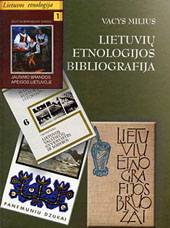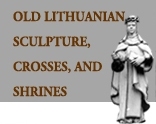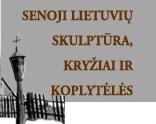Vacys Milius
PREFACE
Any scientific research begins with
bibliographies. In the investigations of folk culture they reveal the
contribution of institutions and individuals and even the attitude of
governments towards the national  cultural
heritage and its use at a concrete time.
cultural
heritage and its use at a concrete time.
Both the Lithuanian investigations of folk culture and compilations of
bibliographic literature were in the focus of attention not only of the
Lithuanians themselves but also of their neighbours with whom the
history fated to maintain contacts - the Poles, Russians, Germans.
Some of them aimed to get to know the subjugated nation, others to
establish with it direct cultural relations. Therefore, bibliographies
appeared in Polish, Russian and German. It is only natural that the
greatest number of bibliographies saw the light when Lithuanian
ethnology evolved into an independent branch of science, i.e., in the
1950s. The publications about Lithuanian folk culture were also
represented in the international science: beginning with the thirties
titles of the books and articles and their translations into German or
English were published in Volkskundliche Bibliographic, Basel,
Switzerland, since 1949 edited in Germany as Internationale
Volkskundliche Bibliographic /International Folklore Bibliography I
Bibliographic Internationale d'Ethnologic, Bonn.
The Lithuanian ethnologic bibliographies, published for more than a
hundred years, can be divided into three groups: chronological, thematic
and personal. The first group is the largest one, whereas personal
bibliographies appear on the occasions of anniversaries. The present
bibliography contains the titles of books and articles published in
scientific and popular scientific works. It includes publications from
the eighteenth century till 1996 inclusive. Judging from bibliographies
the most comprehensively investigated fields of the Lithuanian folk
culture are: folk architecture, wedding customs and folk art (mainly
crosses and miniature chapels). The investigations of folk architecture
were especially popular for the simple reason that many old buildings
survived in the Lithuanian villages, particularly in Zemaitija. Folk
architecture was characterized by a diversity of forms, functions and
decorations. It was described, inventoried and studied by ethnologists,
architects, museum workers and regional ethnographers.
The age-old sophisticated wedding customs attracted the attention of
many researchers. Crosses, miniature chapels and their sculptures,
as a unique phenomena of folk culture, have always been an object of
interest both for Lithuanian and foreign researchers as well. Various
occupational powers and their toadies prohibited the erectioh of new
crosses and chapels and destroyed the already built ones; that, in its
turn, was reflected mthe press. Among the ethnographic regions,
Zemaitija and Southern Dzukija were the ones that attracted the greatest
attention: in the years between the wars and after World War II these
regions, as having preserved best the traits of traditional culture,
were frequently visited by researchers and museum workers. Besides, many
persons, interested in the way of life of their native land, were born
in these regions.
The current bibliography is patterned after the international
bibliography of ethnology issued in Bonn and, of course, taking into
consideration the specific character of the Lithuanian material. For
this reason the entries published in Cyrillic are given together with
the entries published in the Latin alphabet. In the index of personal
names the entries of a concrete author in the Latin alphabet are
immediately followed by the names in Cyrillic. As customs are usually
analysed together with trades and community or family life, the entries
about them are presented in appropriate chapters. The chapter of general
investigations includes the articles of different genres which due to
their scantiness could not be arranged in a separate section. The works
of some authors (S. Daukantas, M. Valancius) were adapted for the use in
schools. In such cases the entries include'only the first edition and
the edition prepared for scientific purposes. There are articles dealing
with two spheres of folk culture. In such cases the article is included
in the corresponding chapter or section the subject of which is
mentioned first in the title of the article. Publications about museums
are given in a separate section when there are more than five entries.
Publications on personalia and folk artists are arranged in the
alphabetic order; the names are printed in italics. If a work was
published in two languages, both languages are given with the equals
sign between them. Pseudonyms and cryptonyms are followed by real names
(if they are known) in square brackets. When the subject-matter is not
clear from the title an annotation is given at the end of the entry
after a dash; the same is done when the title does not indicate the
place. In the section 'Ethnological Materials in Memoirs' the discussed
themes and pages follow after a dash.
No bibliographer who identified and collected publications which
appeared in various languages in several hundred years - particularly
bearing in mind the abundance of publications that appeared in the last
decades in the provinces - can be sure that he/she managed to record all
titles. However, without any doubt all that was done will be of use to
culture researchers, museum workers and all those interested in such
literature.
From book Lietuviu etnologijos
bibliografija. Vilnius, 2001. P. 15-16
THE LITHUANIAN FOLK
MEMORIAL MONUMENTS, SCULPTURES:

